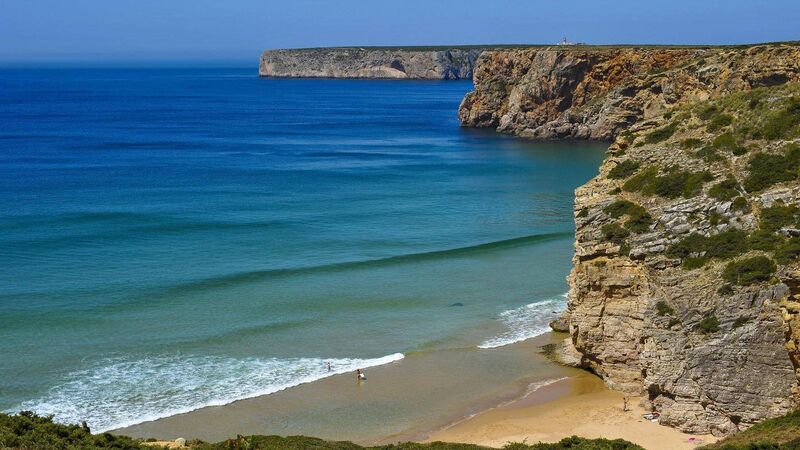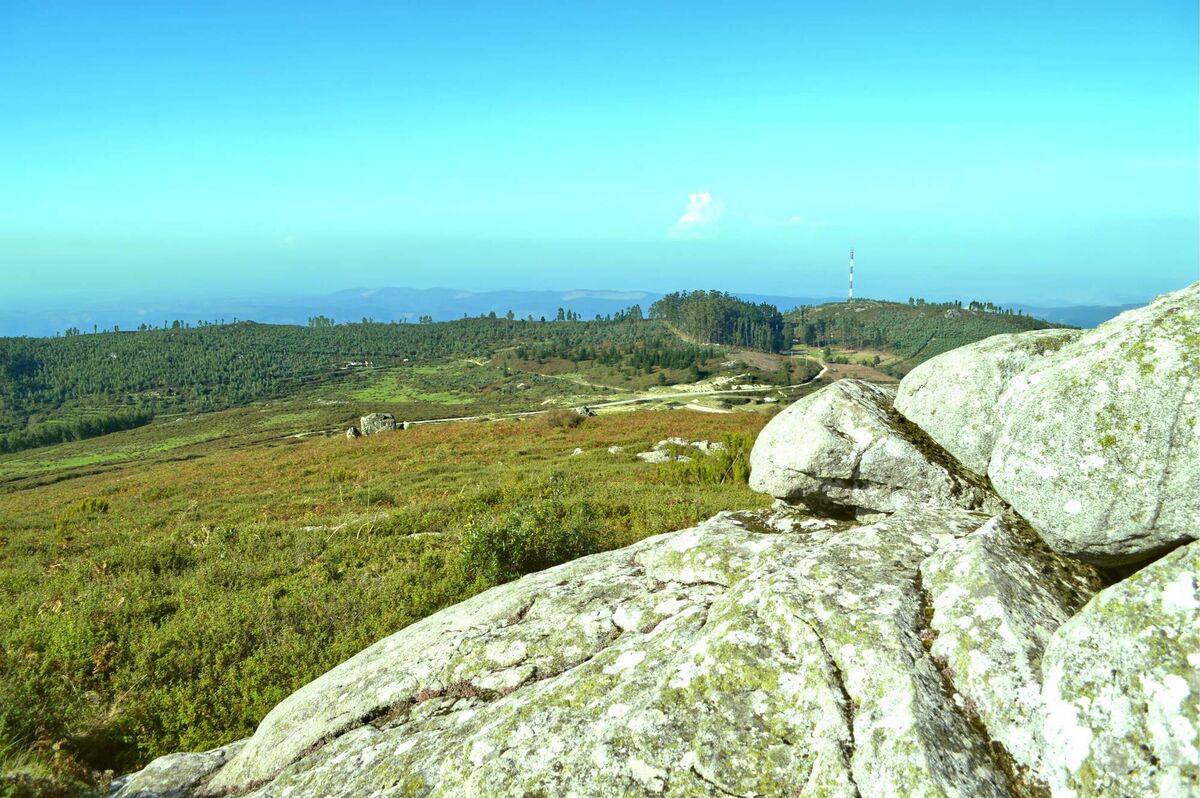Hikes and downtime in the heart of the Algarve

A clifftop beach view on the Rota Vincentina.
Joao may not yet know he is preaching to the converted. “Please drink lots of wine, he urges, “do it for our cork industry in Portugal; the more wine you’ll drink over the coming days the better it is for our economy.”
Rising to the challenge, we go on to enjoy a procession of Algarve wines, alone or with delicious regional dishes, like wild boar with beans and root vegetables, and other specialities at Luar da Foia restaurant near the hillside ancient town of Monchique, and Cataplana, the signature seafood stew at Restaurant Tertulia, dining under the stars in Faro’s historic centre.
Walking tours specialist guide, Joao Silvestre Ministro, will introduce us to his beat, one worlds removed from the overdeveloped popular coastal resorts, crossing Via Algarviana’s unspoilt landscapes of sleepy hamlets, forests, mountains and hidden valleys. The Via Algarviana is a 300 km long trail rich in historical, archaeological, and religious heritage. The route stretches from Alcoutim near the border with Spain to Europe’s furthest south-western point, at Cape St Vincent.
Threatened animal and plant species such as the Eurasian Eagle Owl, Iberian lynx, wildcats, wild boars, rare orchids, narcissi and other endemic plant species can be found in the interior, often not more than an hour inland from the coast, where remote ancient tracks meander alongside carob, olive and citrus groves.

Joao waits at a roadside café beside the Nacional N 2, Portugal’s answer to US Route 66, Europe’s longest continuous road. He takes us to a grassy mound overlooking a field full of cork stripped off trees that grow all around, gathered in massive batches awaiting transportation to factories. Portugal produces 50% of the world’s cork supply, most of it for wine bottle stoppers but this vital centuries-old export is increasingly under threat from cheaper screw tops and plastic corks. Nowadays cork is also sold to the construction (for insulation) and fashion (for handbags, purses, wallets and belts) industries.
On our hike along Via Algarviana to Cortelha Joao delivers insights into this interesting native tree that can live for up to 200 years delivering its re-grown bark bounty every nine years. Cork farming requires much patience taking 25 years before the first harvest. Cork oak forests are sustainable, needing no water nor any human involvement. Thankfully cork oaks act as fireguards to stop infernos that rage through the countryside during the searing hot summers from spreading to homes. Cork oak forests support a rich habitat of birdlife including endangered species, Joao explains. It’s claimed that natural cork has a much smaller carbon footprint than its synthetic competitors, sequestering an estimated 10 million tons of CO2 annually.
Traversing hilly paths, a faint distant ribbon of foaming waves on the coast visible across valleys we take a welcome breather at a small village distillery, where a row of sturdy cork made chairs beckons. To boost local incomes in work starved rural districts like this one, rustic restaurants, farm and guest house accommodation as well as crafts enterprises are on the rise, providing sustainable tourism.
Take a sip of Aguardente de Medronhos, made from the fruit of the arbutus bush, and you’ll soon understand why it’s known as firewater. Demolishing the fiery liquid in one gulp a companion, himself no stranger to hard liquor, drops his tasting glass with a crash of surprise. During the first wave of Covid the Medronhos producing district around Monchique and beyond reported few cases. Once word spread that the firewater offered protection for the populace from the pandemic sales of the potent fruit brandy soared.
Medronhos is traditionally drunk by farmers as an early morning “eye-opener”. Trying a version of it mixed with honey after a hearty lunch at Casa dos Presuntos, a friendly rustic tavern in Cortelha I can’t keep my eyes open on the return journey to our Faro base. But our foray to the city’s state of the art football stadium to watch Ireland draw ahead of Portugal by 1-0 at half-time is a proper eye-opener. But sadly our euphoria is dampened in the closing minutes when predictably Ronaldo scores for the home side, ending our World Cup qualifier dream… a moment when a shot of Medronhos might have lessened our pain.

Day two of our hike through the Algarve’s forested hinterland takes us into the mountain range of Sierra Monchique, putting calf muscles to the test on the 900- metre gradual climb to Foia, at 902 m the highest point in the Algarve above Monchique. Exiting the town’s atmospheric narrow cobbled uphill lanes and buildings Joao pauses at a couple of massive cork oaks bearing cuts inflicted by axe wielding harvesters who skilfully skin off the intact bark. It is a skill passed down through the generations. “The harvesters climb the trees like spiders”, he says, “it can be difficult now to find people to do this tough manual work , today’s youth prefer to work in offices or tourist hotels”.
I feel more like a snail than a spider a few hours later, creeping over giant boulders to reach Foia’s peak in the blistering noon heat but the incredible panoramic views beyond are reward enough after all.
Surfers flock to the Algarve all year round for the best swells of the western shore. Instead we get our thrills racing across the bay with Cape Cruiser (www.capecruiser.pt) in a vain search for dolphins, enjoying a vista of coastline cliffs and caves. Next morning we view wild beaches above Praia do Amado taking a 9 km Rota Vicentina circular trail over clifftops and remote red ochre paths where wild plants and aromatic shrubs flourish. Our super fit intrepid leader Marta Cabral, CEO of Rota Vicentina advises visitors to walk in springtime and autumn and never summer along renowned rural and coastal walking networks that includes a 200 km long Fisherman’s Trail.
Our base at a lovely arty boutique property Memmo Bleeira overlooking Sagres harbour the westernmost point in southern Portugal is a Zen-like hideaway – the other Algarve on the coast.
A decade ago the hamlet of Pedralva had fewer than 10 inhabitants and many of the houses were in an advanced state of ruin. Now they have new life and dignity thanks to a group of friends from Lisbon who set about renovating thirty of them, creating an eco-tourism peaceful retreat in the heart of the Costa Vicentina Parque Natural, hidden away in a valley of cork and eucalyptus trees. It’s a place of slow tourism, trekking, cycling on quiet back roads, escape from the rest of the world. There is neither Wi-fi nor TV in the cottages and that’s the point.
Our lunch of traditional oven-baked salted cod with organic spinach and boiled potatoes is chosen by Marta and Ana Vargues, nature, sport and wellness expert for the AlgarveTourist board, finishing off with a regional favourite, sweet potato pudding laced with honey and orange. Throughout we inspect the wine corks to ensure they’re the real thing… it goes without saying that they pass with flying colours!
- Hiking the entire 300 km of Via Algarviana can be tackled in stages, from 7 to 16 days with Proactivetur
- The cost is approximately €500 which includes guest and farmhouse accommodation for 8 days, including some meals at rustic restaurants. At the end of each sector, a passport is stamped, proving you made the entire journey.
- Irish tour operators TDactive Holidays and Follow the Camino offer this renowned trail too.
- Rota Vicentina is one of Europe’s most spectacular and unspoilt walking trails covering 750 km, a classic long-distance footpath. Its Historical Way passes through several towns and villages, the Fisherman’s trail follows the coast. Circular routes start and finish at the same place.
- For ideas and inspiration about the ‘other Algarve’ see visitalgarve.pt, visitportugal.com and viaalgarviana.org
- In Faro Isabel stayed at stylish Cardeal Suites & Apartments in the atmospheric old downtown district, from €99 doubles pn, a beautifully designed low rise property on the site of a former neighbourhood garage.
- The best sunset views at the surfers' mecca of Sagres which teeters on the edge of the continent is 4 star Memmo Baleeira which overlooks the southwesternmost harbour in Europe. Doubles with breakfast from €124.
- Aer Lingus operates daily flights to Faro from Dublin, reducing to twice weekly flights for winter schedule from November 1, fares starting from €49.99 one-way including taxes and charges.
- The airline’s ‘book with confidence’ flexible booking option allows customers on any fare type to change their flights without a change fee up to two hours before they fly.






